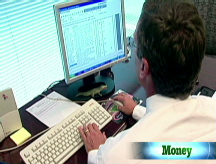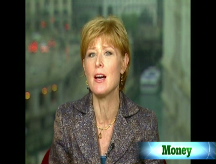Treasurys rally on economic weakness
Yields on government debt fall to historic lows as investors flock to the safety of U.S. debt.
NEW YORK (CNNMoney.com) -- Yields on long-term U.S. Treasury debt fell further Monday - after sinking to historic lows last week - as the grim economic outlook continued to drive demand for ultra-safe government debt investments.
The 30-year note jumped 4-19/32 to 124-7/32. Its yield fell to an all-time low of 3.20%, down from 3.54% in the previous session, before recovering slightly to end the session at 3.22%.
The benchmark 10-year note rose 1-21/32 to 108-26/32 and its yield fell to 2.74% from 2.99% on Friday. Last week, the 10-year yield fell below 3% for the first time since the note was first issued in 1962.
Short-term Treasurys also advanced. The 2-year note was up 6/32 to 100-22/32 and its yield fell to 0.91% from 1.09%.
The yield on the 3-month Treasury was 0.03%, even with Friday.
Bond prices and yields move in opposite directions, and lower yields suggest that investors are less concerned with profit and more focused with safety.
"In the near term, the economic news is still challenging," said Michael Strauss, chief economist at investment firm Commonfund, which manages about $42 billion in assets. "It is likely to be another dominating force today," he added.
As the government looks to finance its massive rescue of the financial system, it continues to sell debt to raise capital. Monday, the Treasury auctioned $28 billion worth of 91-day bills and another $28 billion worth of 182-day bills.
Economic news: The market's long-held belief that the economy is in a recession was officially confirmed Monday by the National Bureau of Economic Research.
NBER, a private group of leading economists that officially dates the start and end of economic downturns, said the nation has been in a recession since December 2007. At nearly a year in duration, the current recession is one of the longest downturns since the Great Depression.
Adding to the grim picture: a pair of economic reports released Monday that highlighted weakness in construction and manufacturing activity.
A government report showed construction spending fell more than expected in October as builders continue to struggle with the weak economy and tight credit.
The Commerce Department said spending on construction dropped 1.2% in October after a 0.3% decline in September. It was a much larger than the 0.9% drop economists had expected.
Separately, a report from the Institute for Supply Management showed the nation's manufacturing sector continues to deteriorate.
The ISM's index of manufacturing activity fell to a reading of 36.2% in November from 38.9% in October. The index now stands at its lowest level since May 1982 when the economy was mired in recession.
The barrage of bad economic news punished the stock market. The Dow Jones industrial average ended down 680 points, its fourth-biggest single-session decline on a point basis ever.
Convexity buying: Treasury prices were also being supported by increased "convexity buying" in response to the Federal Reserve's decision to buy mortgage-backed securities held by government-sponsored lenders Fannie Mae (FNM, Fortune 500) and Freddie Mac (FRE, Fortune 500).
In this case, convexity buying occurs when holders of mortgage-backed securities purchase long-term Treasurys to raise the average duration of their portfolios. As the government buys more mortgage-backed securities, demand for long-term notes has spiked.
"The demand is coming from either convexity buying needs or real fears of deflation," said Andrew Brenner, senior vice president at MF Global in New York.
Economists have expressed concern recently that rapidly falling prices for certain commodities like crude oil will lead to deflation.
Deflation occurs when the prices that consumers and businesses pay for goods and services fall as a result of weak demand. It is typically associated with depression or prolonged economic distress.
Treasurys, however, are highly inflation averse, since rising prices erode the value of fixed-income investments. So the prospect of deflation can effectively increase the value of Treasurys.
Bank lending: Lending rates were mixed Monday. The 3-month Libor rate was unchanged at 2.22%, according to Bloomberg. The overnight Libor eased to 1.09% from 1.16% on Friday.
Libor, the London Interbank Offered Rate, is a daily average of interbank lending rates and a key barometer of liquidity in the credit market. More than $350 trillion in assets are tied to Libor.
Meanwhile, two key indicators reflected a lack of liquidity and the market's aversion to risk.
The Libor-OIS spread widened slightly to 1.83 percentage points from 1.78 points on Friday. The spread measures the difference between actual borrowing costs and the expected targeted borrowing rate from the Fed. It is used as a gauge to determine how much cash is available for lending between banks. The bigger the spread, the less cash is available for lending.
Another indicator, the TED spread, rose modestly to 2.19 percentage points from 2.17 points. The TED spread measures the difference between the 3-month Libor and the 3-month Treasury bill, and is a key indicator of risk. The lower the spread, the more willing investors are to take risks. ![]()




